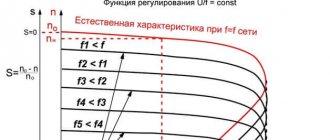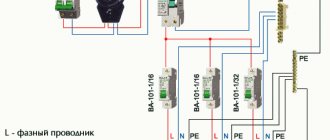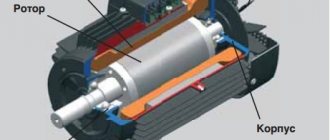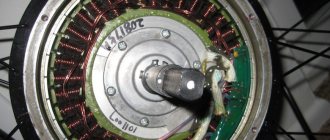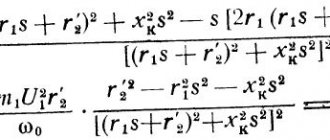For other meanings, see Revolutions per minute (disambiguations).
"rpm" redirects here. For other uses, see rpm (disambiguation).
| This article requires additional links for verification . |
| RPM | |
| Unit | Rotational speed |
| Symbol | rpm or rpm |
| Conversions | |
| 1 rpm in... | … equals … |
| Angular velocity SI | 2π/60 rad/s ≈ 0.1047198 rad/s |
| SI frequency | 1/60 Hz ≈ 0.01666667 Hz |
| Derived speed SI | 1/60s −1 .1/60/s |
| Derived rotation speed SI | 1 min −1.1 / min |
RPM
(abbreviated
rpm
,
rpm
,
rpm
,
rpm
, or with the symbol min-1) is the number of revolutions in one minute. It is a unit of rotational speed or frequency from rotation around a fixed axis.
International system of units [edit]
According to the International System of Units (SI), rpm is not a unit. This is because the word revolution
is more of a semantic annotation than a unit of measurement. If necessary, the annotation is made as a subscript of the formula sign. Because of the physical quantity being measured, the sign of the formula must be f for (rotational) frequency and or for angular velocity. The corresponding SI base derived unit is c -1 or . When measuring angular velocity, units of radians per second are used.
| 1 rad/s = 1 2 π Hz = 60 2 π rpm 2 π rad/s = 1 Hz = 60 rpm 2 π 60 rad/s = 1 60 Hz = 1 rpm {\displaystyle {\begin{aligned}1~&{\text{rad/s}}&&=&{\frac {1}{2\pi }}~&{\text{Hz}}&&=&{\ frac {60}{2\pi }}~&{\text{rpm}}\\[9pt]2\pi ~&{\text{rad/s}}&&=&1~&{\text{Hz}} &&=&60~&{\text{rpm}}\\[9pt]{\frac {2\pi }{60}}~&{\text{rad/s}}&&=&{\frac {1}{ 60}}~&{\text{Hz}}&&=&1~&{\text{rpm}}\end{aligned}}} |
Although they have the same dimensions (s-1), hertz (Hz) and radians per second (rad/s) are two different units representing two different but proportional quantities of ISQ: frequency and angular frequency (angular velocity, magnitude of angular velocity ). ). Conversion between frequency f (measured in hertz) and angular velocity ω (measured in radians per second):
ω = 2 π f , f = ω 2 π . {\displaystyle \omega =2\pi f\,,\qquad f={\frac {\omega }{2\pi }}\,.}
Thus, a disk spinning at 60 rpm is said to be spinning at 2 π rad/s or 1 Hz, where the former measures angular velocity and the latter reflects the number of revolutions per second.
If the non-SI unit rpm is considered a unit of frequency, then 1 rpm = 1/60Hz. If instead it is considered to be a unit of angular velocity, and the word "rotation" means 2π radians, then 1 rpm = 2 π/60rad/s.
Angular velocity in sports
Angular velocity is often used in sports. For example, athletes decrease or increase the angular velocity of a golf club, bat, or racket to improve performance. Angular velocity is related to linear velocity such that of all the points on a segment rotating about a point on that segment, that is, about the center of rotation, the point furthest from that center moves at the highest linear speed. So, for example, if a golf club is spinning, the end of that club furthest from the center of rotation moves at the highest linear speed. At the same time, all points on this segment move with the same angular velocity. Therefore, by lengthening the club, bat, or racket, the athlete also increases the linear speed, and accordingly the speed of impact transmitted to the ball, so that it can fly a greater distance. Shortening the racket or club, even gripping it lower than usual, on the contrary, slows down the speed of the strike.
In the primitive communal system, men were the main hunters
Athletes with longer arms and legs achieve greater angular velocity
Tall people with long limbs have an advantage in terms of linear speed. That is, by moving their legs at the same angular speed, they move their feet at a higher linear speed. The same thing happens with their hands. This advantage may be one of the reasons that in primitive societies men hunted more often than women. It is likely that taller humans also benefited in the evolutionary process because of this. Long limbs helped not only in running, but also during hunting - long arms threw spears and stones with greater linear speed. On the other hand, long arms and legs can be an inconvenience. Long limbs have more weight and require additional energy to move them. In addition, when a person runs fast, long legs move faster, which means that when they collide with an obstacle, the impact will be stronger than for people with short legs who move at the same linear speed.
Gymnastics, figure skating and diving also use angular velocity. If an athlete knows the angular velocity, then it is easy to calculate the number of flips and other acrobatic tricks during a jump. During somersaults, athletes typically press their legs and arms as close to their body as possible to reduce inertia and increase acceleration, and therefore angular velocity. On the other hand, during a dive or landing, judges look at how smoothly the athlete lands. At high speeds, it is difficult to regulate the direction of flight, so athletes deliberately slow down the angular velocity by slightly extending their arms and legs away from the body.
Athletes who throw discus or hammer throw also control linear speed using angular speed. If you just throw the hammer without rotating it in a circle on a long steel wire that increases the linear speed, then the throw will not be as strong, so the hammer is first spun. Olympic athletes rotate on their axis three to four times to increase their angular velocity to the maximum possible.
Examples[edit]
Main article: Orders of magnitude (angular velocity)
- On many types of disk recording media, the rotation speed of the media under the read head is standard and is expressed in rpm. Phonograph (gramophone) recordings, for example, typically rotate continuously at 16 2⁄3, 33 1 ⁄ 3, 45 or 78 rpm (0.28, 0.55, 0.75 or 1.3 Hz respectively).
- Modern air turbine dental drills can spin at speeds of up to 800,000 rpm (13.3 kHz).
- The second arm of conventional analog rotates at 1 clock revolutions per minute.
- Audio CD players read their discs at a precise constant speed (4.3218 Mbit/s raw physical data for 1.4112 Mbit/s (176.4 kB/s) usable audio data) and therefore must vary the disk rotation speed from 8 Hz (480 rpm) when reading on the innermost edge to 3.5 Hz (210 rpm) on the outer edge. [1]
- DVD players also typically read discs at a constant linear speed. The disk rotation speed varies from 25.5 Hz (1530 rpm) when reading on the inner edge to 10.5 Hz (630 rpm) on the outer edge. [1]
- A drum washing machine can rotate at speeds from 500 to 2000 rpm (8-33 Hz) during the spin cycle.
- The turbine for generating electricity (with a two-pole alternator) rotates at 3000 rpm (50 Hz) or 3600 rpm (60 Hz), depending on the country - see AC plugs and sockets.
- Modern automobile engines typically operate at about 2,000–3,000 rpm (33–50 Hz) at cruise, with a minimum speed (idle) of about 750–900 rpm (12.5–15 Hz) and an upper limit 4,500 to 10,000 rpm (75–166 Hz) for a road car, or almost (sometimes higher) 20,000 rpm for racing engines, such as in Formula 1 cars (during the 2006 season with the 2.4 LN/A engine V8; currently limited to 15,000 rpm, with 1.6 L V6 turbo - hybrid engine configurations). [2] The exhaust sound of V8 F1 cars is much higher than that of the I4 engine, because each of the cylinders of a single four-stroke engine fires once for every two revolutions of the crankshaft. Thus, an eight-cylinder engine spinning 300 times per second would have an exhaust frequency of 1200 Hz.
- A piston aircraft engine typically rotates at 2000 to 3000 rpm (30–50 Hz).
- Computer hard drives typically spin at 5400 or 7200 rpm (90 or 120 Hz), which are the most common speeds for ATA or SATA drives in consumer models. High-performance drives (used in file servers and enthusiast gaming PCs) spin at 10,000 or 15,000 rpm (160 or 250 Hz), typically with higher-end SATA, SCSI, or Fiber Channel interfaces and smaller platters to To achieve these higher speeds, reducing drive capacity and maximizing front-end speeds pays off in much lower access times and average transfer speeds thanks to the high rotation speed. Until recently, it was possible to find inexpensive and energy-efficient laptop drives with spindle speeds of 4200 or even 3600 rpm (70 and 60 Hz), but they have fallen out of favor due to their lower performance, improvements in energy efficiency in faster models, and use solid state drives for use in thin and ultraportable laptops. Like CD and DVD media, the amount of data that can be stored or read for each rotation of the platter is greater at the outer edge than near the spindle; however, hard drives maintain a constant spin speed, so the effective data transfer rate is higher at the edge (usually the "beginning" of the disk, as opposed to a CD or DVD).
- Floppy disk drives typically operated at 300 or sometimes 360 rpm (relatively slow 5 or 6 Hz) with a constant data density per revolution, which was simple and inexpensive to implement, although inefficient. Some designs, such as those used on older Apple computers (Lisa, early Macintosh, later II), were more complex and used variable rotation speeds and storage densities per track (at a constant read/write speed) to store more data on disk; e.g. 394 RPM (with 12 sectors per track) to 590 RPM (8 sectors) with a dual-density 800 KB Mac drive at a constant 39.4 KB/s (max) - up from 300 RPM min, 720 KB and 23 KB/s (max) for dual-density drives in other machines. [3]
- The Zippe-type centrifuge for uranium enrichment rotates at 90,000 rpm (1,500 Hz) or faster. [4]
- Gas turbine engines rotate at speeds of tens of thousands of revolutions per minute. JetCat model aircraft turbines are capable of speeds in excess of 100,000 rpm (1,700 Hz), with the fastest being 165,000 rpm (2,750 Hz). [5]
- The flywheel energy storage system operates in the range of 60,000–200,000 rpm (1–3 kHz), using a passively magnetic flywheel levitated in a vacuum. [6] The flywheel material is not selected from the densest, but from the one that grinds most safely, at surface speeds of approximately 7 times the speed of sound.
- A typical 80mm diameter, 30 CFM computer fan will spin at 2600–3000 RPM (43–50 Hz) when powered by a 12V DC source.
- A millisecond pulsar can spin near 50,000 revolutions per minute (833 Hz).
- The turbocharger can reach 290,000 rpm (4.8 kHz), while 80,000-200,000 rpm (1-3 kHz) is common.
- The supercharger can rotate at speeds from or at 50,000-65,000 rpm (833-1083 Hz)
- Molecular microbiology - molecular engines. Rotation speeds of bacterial flagella have been measured to be 10,200 rpm (170 Hz) for Salmonella typhimurium
, 16,200 rpm (270 Hz) for
Escherichia coli
, and up to 102,000 rpm (1700 Hz) for the polar flagellum
of Vibrio alginolyticus
, which allows the latter The organism moves in simulated natural conditions with a maximum speed of 540 mm/h. [7]
Excerpt characterizing Revolutions per minute
The doctor who arrived that day examined Natasha and ordered her to continue the last powders that he prescribed two weeks ago. “We must continue, morning and evening,” he said, apparently conscientiously pleased with his success. - Just please be more careful. “Be calm, Countess,” the doctor said jokingly, deftly picking up the gold in the pulp of his hand, “soon he’ll start singing and frolicking again.” The last medicine is very, very good for her. She's very refreshed. The Countess looked at her nails and spat, returning to the living room with a cheerful face. At the beginning of July, more and more alarming rumors about the progress of the war were spreading in Moscow: they were talking about the sovereign’s appeal to the people, about the arrival of the sovereign himself from the army to Moscow. And since the manifesto and appeal were not received before July 11, exaggerated rumors circulated about them and about the situation in Russia. They said that the sovereign was leaving because the army was in danger, they said that Smolensk had been surrendered, that Napoleon had a million troops and that only a miracle could save Russia. On the 11th of July, Saturday, the manifesto was received, but not yet printed; and Pierre, who was visiting the Rostovs, promised to come for dinner the next day, Sunday, and bring a manifesto and an appeal, which he would get from Count Rastopchin. This Sunday, the Rostovs, as usual, went to mass at the Razumovskys’ home church. It was a hot July day. Already at ten o'clock, when the Rostovs got out of the carriage in front of the church, in the hot air, in the shouts of the peddlers, in the bright and light summer dresses of the crowd, in the dusty leaves of the trees of the boulevard, in the sounds of music and the white trousers of the battalion marching on the march, in the thunder of the pavement and in the bright shine of the hot sun there was that summer languor, contentment and dissatisfaction with the present, which is felt especially sharply on a clear hot day in the city. In the Razumovsky church there were all the Moscow nobility, all the acquaintances of the Rostovs (this year, as if expecting something, a lot of rich families, usually traveling to the villages, remained in the city). Walking behind the livery footman, who was parting the crowd next to her mother, Natasha heard the voice of a young man speaking about her in a too loud whisper: “This is Rostova, the same one...” “How thin she has become, but still good!” She heard, or it seemed to her, that the names of Kuragin and Bolkonsky were mentioned. However, it always seemed that way to her. It always seemed to her that everyone, looking at her, only thought about what happened to her. Suffering and fading in her soul, as always in a crowd, Natasha walked in her purple silk dress with black lace the way women can walk - the calmer and more majestic the more painful and ashamed she was in her soul. She knew and was not mistaken that she was good, but this did not please her now as before. On the contrary, this was what tormented her most recently, and especially on this bright, hot summer day in the city. “Another Sunday, another week,” she said to herself, remembering how she was here on that Sunday, “and still the same life without life, and all the same conditions in which it was so easy to live before. She’s good, she’s young, and I know that now I’m good, before I was bad, but now I’m good, I know,” she thought, “and so the best years pass in vain, for no one.” She stood next to her mother and exchanged words with nearby acquaintances. Natasha, out of habit, examined the ladies’ dresses, condemned the tenue [demeanor] and the indecent way of crossing herself with her hand in the small space of one lady standing nearby, again thought with annoyance that she was being judged, that she too was judging, and suddenly, hearing the sounds of the service, she was horrified by her abomination, horrified that her former purity had again been lost by her. The handsome, quiet old man served with that gentle solemnity that has such a majestic, calming effect on the souls of those praying. The royal doors closed, the curtain slowly closed; a mysterious quiet voice said something from there. Tears, incomprehensible to her, stood in Natasha’s chest, and a joyful and painful feeling worried her. “Teach me what I should do, how I can improve forever, forever, what I should do with my life...” she thought. The deacon went out to the pulpit, straightened his long hair from under his surplice, holding his thumb wide, and, placing a cross on his chest, loudly and solemnly began to read the words of the prayer:
Links[edit]
- ^ ab "Physical parameters". DVD Technical Notes
. Moving Picture Experts Group (MPEG). 1996-07-21. Retrieved May 30, 2008. - "Season 2014". Formula 1 . Retrieved August 18, 2014.
- "Double the Density of High Density Discs". Apple. Retrieved May 5, 2012.
- "Slender and elegant, he powers the bomb". Electric Power Forum. Retrieved September 24, 2006.
- "P60-SE Special Edition". JetCat USA. Retrieved July 19, 2006.
- Post, Richard F. (April 1996). "A New Look at an Old Idea: The Electromechanical Battery" (PDF). Science and Technology Review
. University of California: 12–19. ISSN 1092-3055. Retrieved May 30, 2008. - Magariyama, Y.; Sugiyama, S.; Muramoto, K.; Maekawa, Y.; Kawagishi, I.; Imae, Y.; Kudo, S. (27 October 1994). "Very fast rotation of flagella." Nature
.
371
(6500): 752. Bibcode: 1994Natur.371..752M. DOI: 10.1038/371752b0.
Why is high crankshaft rotation speed harmful?
The “slipper to the floor” driving style implies constant spinning of the crankshaft up to 5–8 thousand revolutions per minute and late shifting of gears, when the noise of the engine literally rings in your ears. What are the consequences of this driving style, besides creating emergency situations on the road:
- all components and assemblies of the car, and not just the engine, experience maximum loads during their service life, which reduces the total resource by 15–20%;
- due to the intense heating of the engine, the slightest failure of the cooling system leads to major repairs due to overheating;
- exhaust pipes burn out much faster, and with them an expensive catalyst;
- transmission elements wear out quickly;
- Since the crankshaft rotation speed exceeds normal speed by almost twice, fuel consumption also increases by 2 times.
Running a car “to break” has an additional negative effect associated with the quality of the road surface. Driving at high speed on uneven roads literally kills suspension elements, and in the shortest possible time. It is enough to fly your wheel into a deep pothole and the front strut will bend or crack.
The general technical condition of the car, including its engine, cooling system, transmission and much more, can always be checked using a personal ODB-II auto scanner. One of the best representatives of this type of device is the Korean-made scanner Scan Tool Pro Black Edition.
In addition to accurate diagnostics of all components and assemblies of the car, the auto scanner is capable of displaying revolutions, oil pressure, readings from all sensors, etc. in real time. The scanner is compatible with most cars with an ODB-II connector and is quite easy to use. Information about the condition of your car can always be displayed on any device running iOS, Android or Windows.
